My association with Domke bags goes back to their earliest days. When I first became interested in photography, the brands serious photographers lusted after were Domke, Billingham and Lowe Pro.
Billingham's were the Rolls Royce of bags, loved by world travellers and still a favourite of many. Domke's were the character filled photo journalists bags (and designed by one) and the Lowe pro's were the work horse problem solvers and outdoor expedition bags.
None of the brands had a lot of choice, Domke being the worst (best?) offender, with only the F2 at first, then F1 (bigger) and F6 (smaller) bags, all basically the same design. I purchased two things in the late 80's that stayed with me for a long time. A Manfrotto 055 (still going but owned by someone else) and a black F2. The F2 has been given away, gifted back and used more or less consistently for 35 years and is pretty much the only thing that has not changed through my whole photographic life.
The only other Domke I own at the moment was a purchase of weakness. When in Japan last year I found a bag that I had not seen before, a F3x rugged-wear in olive. The rugged wear bags are lighter and more weather resistant than the standard canvas Domkes, but have only been available in brown with light trim as far as I knew. Japan has a special relationship with Domke, often getting special edition or bespoke bags just for their market. I left the shop empty handed, but returned soon after. To put this into perspective, I was in the process of clearing out a lot of bags, two Domke f3x's (canvas olive and ballistic) included, so getting this was a little crazy.
Enough of my sordid recent history, lets look at the bags.
Age before beauty, the F2.
Looking a bit aged (and dirty), the F2 black canvas from 1980 something.
Notice the colour variation. The main strap has been replaced because it faded a yellowish brown like the front straps. It is a bit of a badge of honour having a faded Domke, but was really a bit too ugly for my tastes. Now I have to wait 10-15 years before the strap matches the rest! The bag still sits up proudly, with a veteran swagger, even after all of these years.
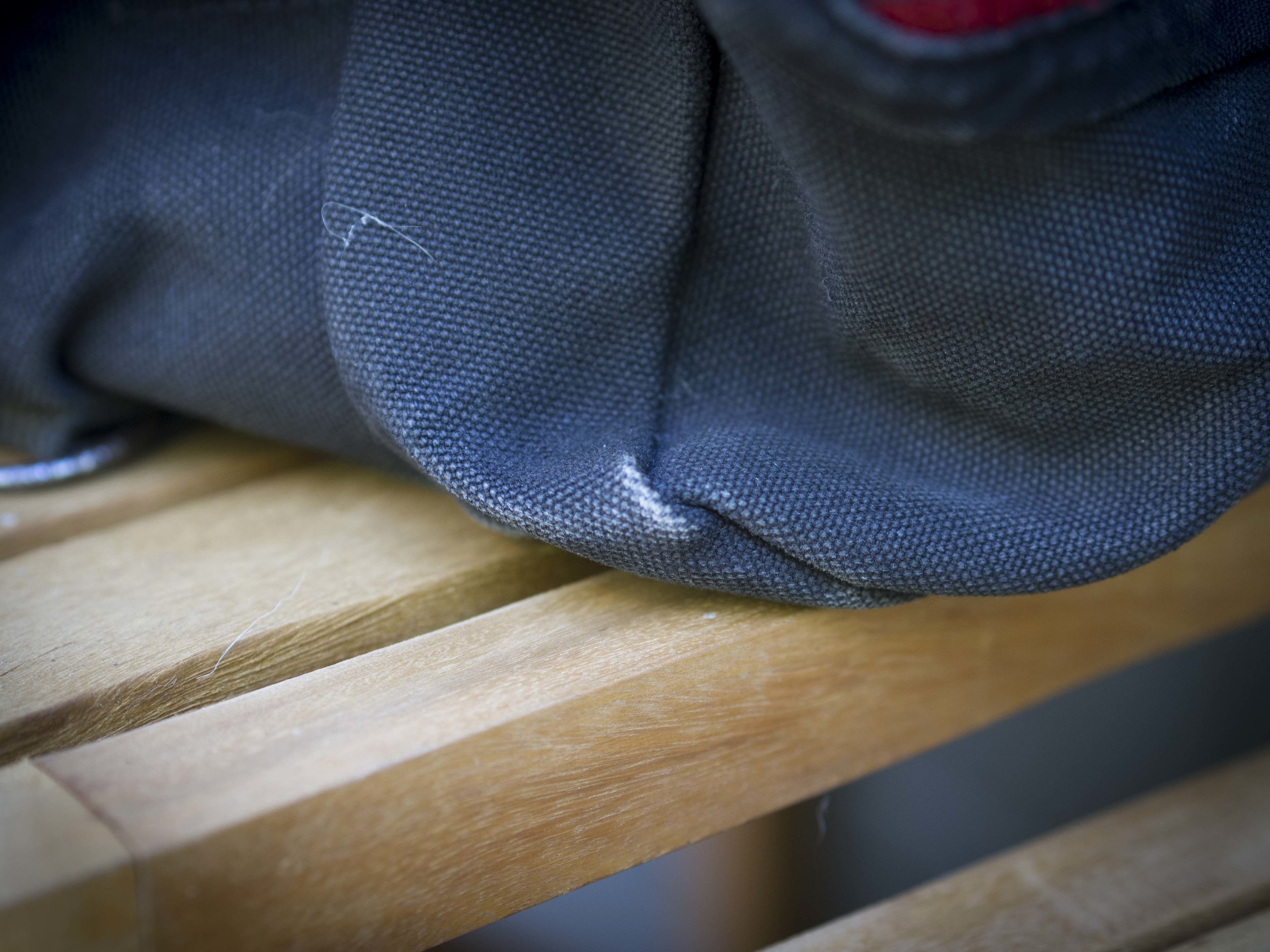

Above is a detail shot of the most worn part of the bag and the inside "lid" pocket (great for valuables), the front straps and the amazing "postal" shoulder pad. All Domke straps come with rubber veins running their length to reduce slipping. The shoulder pad is very good at that also and is very efficient at absorbing downward pressure. The fluffy mess on the right is from me cutting of a label clumsily, years ago.
What does it hold?
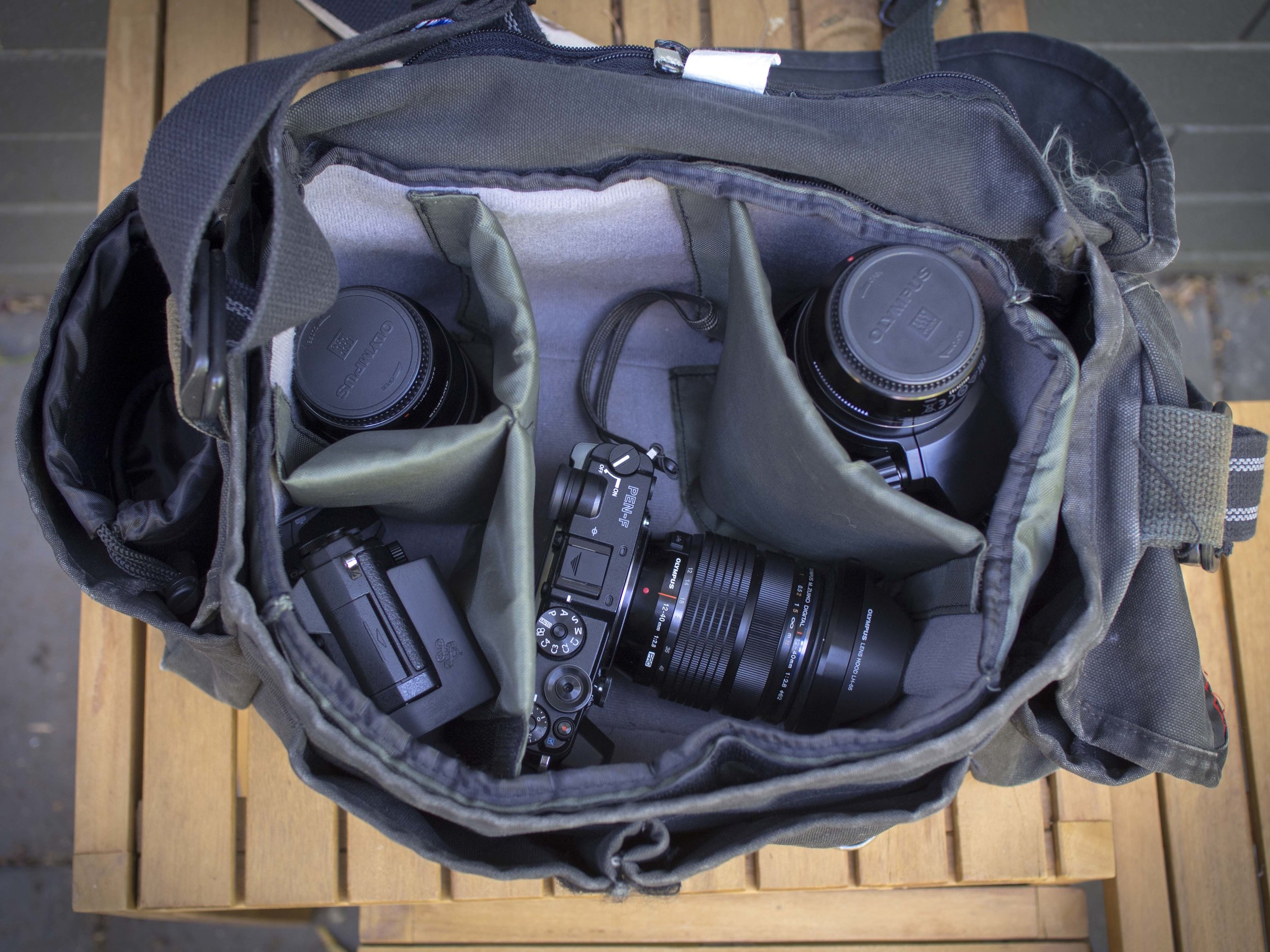
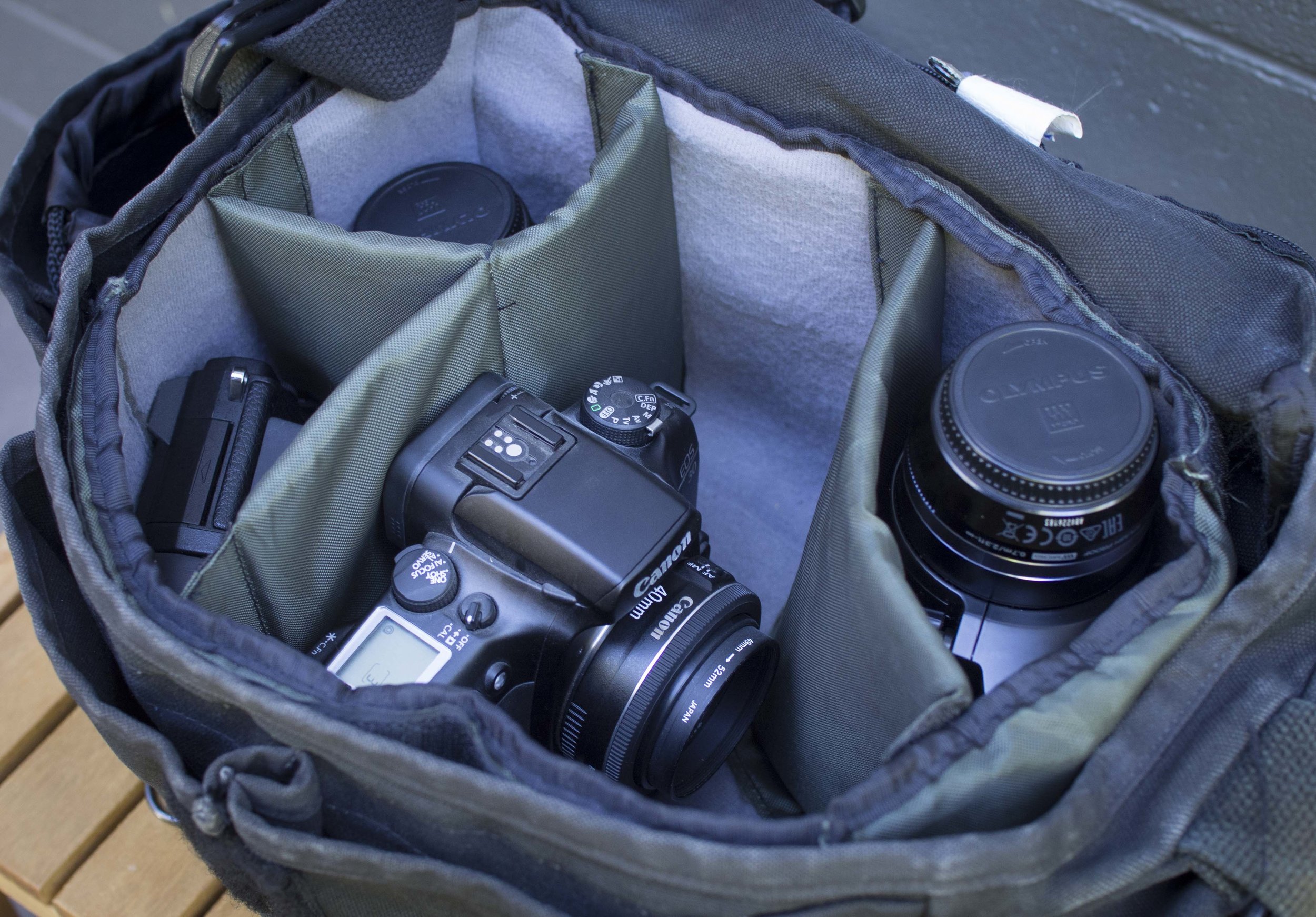
Simply put, enough gear to make your back ache, but doing it better than most bags its size.
The left hand image, shows it has room for a lot of M43 gear, but tends to swallow it. The compartments are fully flexible, with lots of options to buy (the main insert is a replacement) and the bag hip-hugs well even when full and an advantage of the canvas, like leather is that it gets better with age, not just older.
Domke padding is light and thin, but effective. No doubt I could get a lot more in, especially if I use the end pockets that would hold a camera body with a pancake lens on. The end pocket (open) has a neoprene lens bag for added protection and I have lined the bottom with thin foam for drop protection (my F2 has the old rigid wood panel with rubber coating floor). Nothing I have ever put in a Domke has ever been broken, which I put down to the feeling of “bag awareness” they provide.
The right hand image is to show the height using an old EOS 30 with grip for scale. Easily enough to hold a medium long lens upright (my 40-150 is on the right with metal hood on) or a pro Canon/Nikon body. All of the early Domke bags were designed for pro SLR's with motor drives and F2.8 zoom lenses or fast primes (I always picture in my head a pair of FM2's with drives and a 20/35/85/180 kit).
The two front pockets are roomy enough for any phone, notebook a medium sized flash. The back has a full length pocket capable of taking a full sized ipad or small lap top, but without a flap or any protection.
Complaints? Only my usual one about a weather resistant pocket on the back without a top cover or drainage holes and I have been worrying for years that something will fall out of an open topped front pocket, but nothing has. Oh and the metal flap clips that can whack a camera pretty hard (fixed with a little tape).
Loves? Durability, consistency and functionality...big time. It sits really well on the hip.
Things that can be both good and bad. Carries lots, looks old and worn and is thinly padded.
Now the F3x.
The less rigid rugged wear look. Remember this bag is only a year old.
Already looking like a worn in bag (probably why newer Domke bags don't seem to take with me, as they look too new compared to the F2), the rugged wear olive F3x is a darker, less military surplus and smoother looking fabric than the regular canvas version. It is also much lighter in weight.
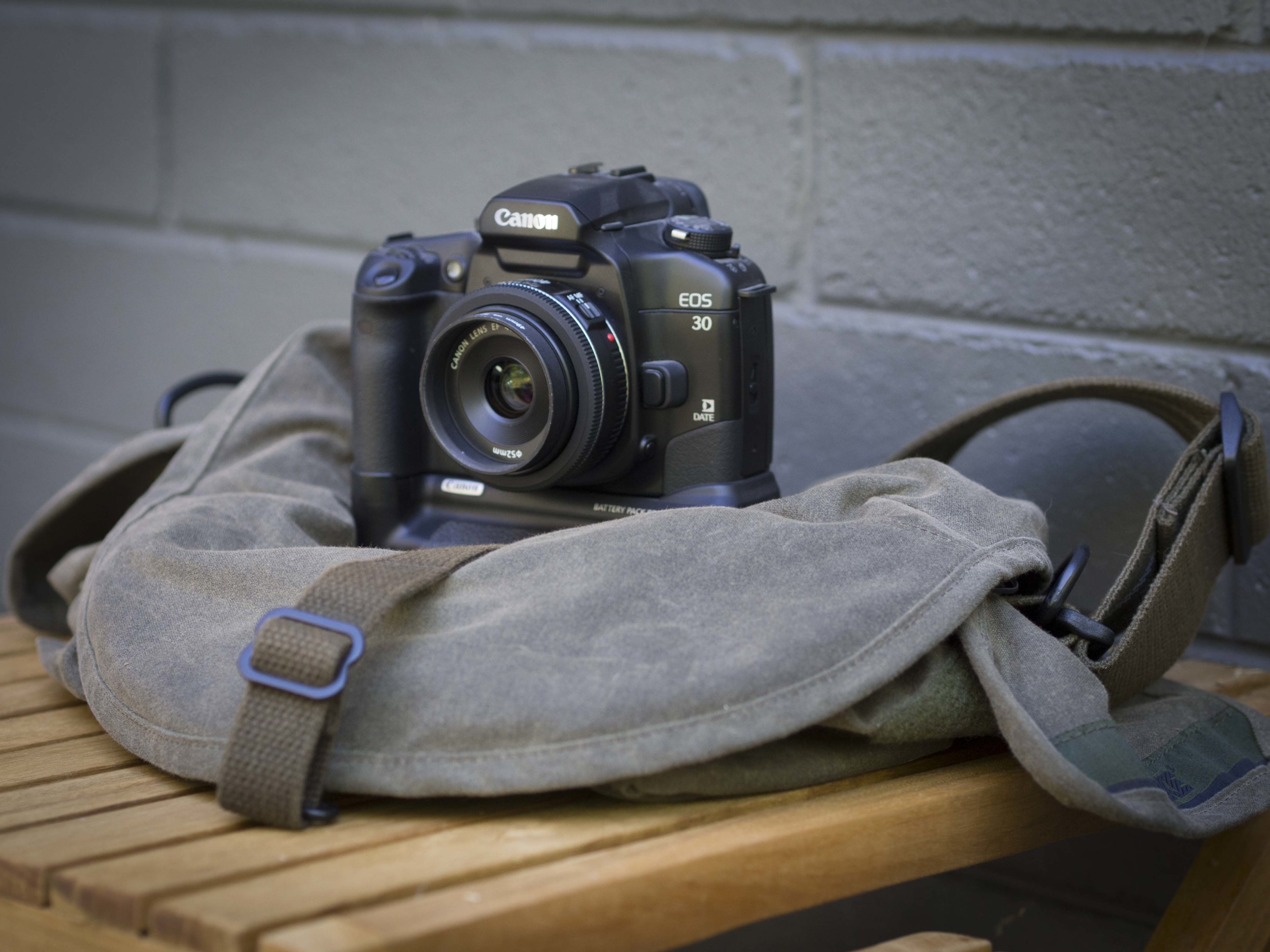
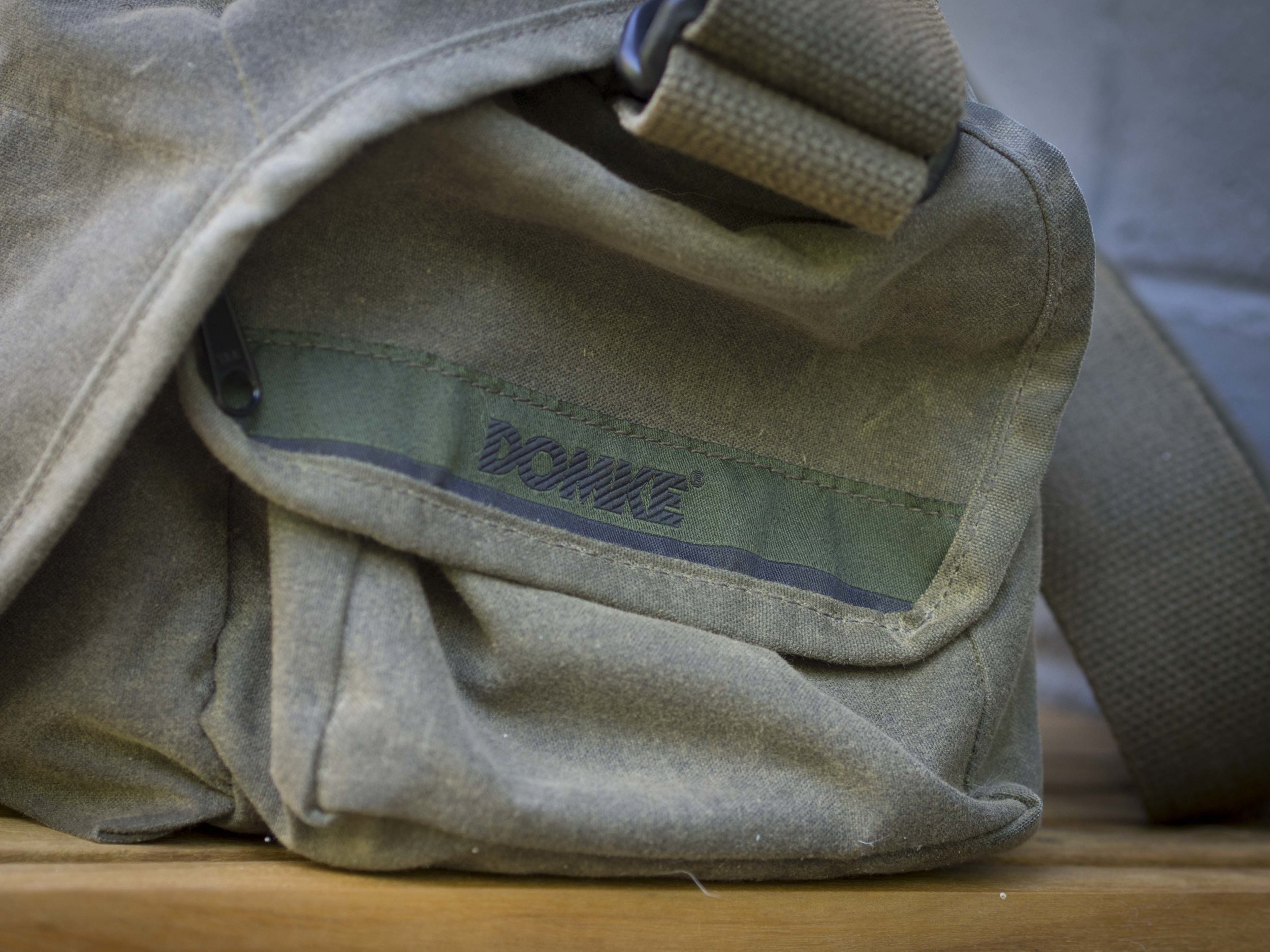
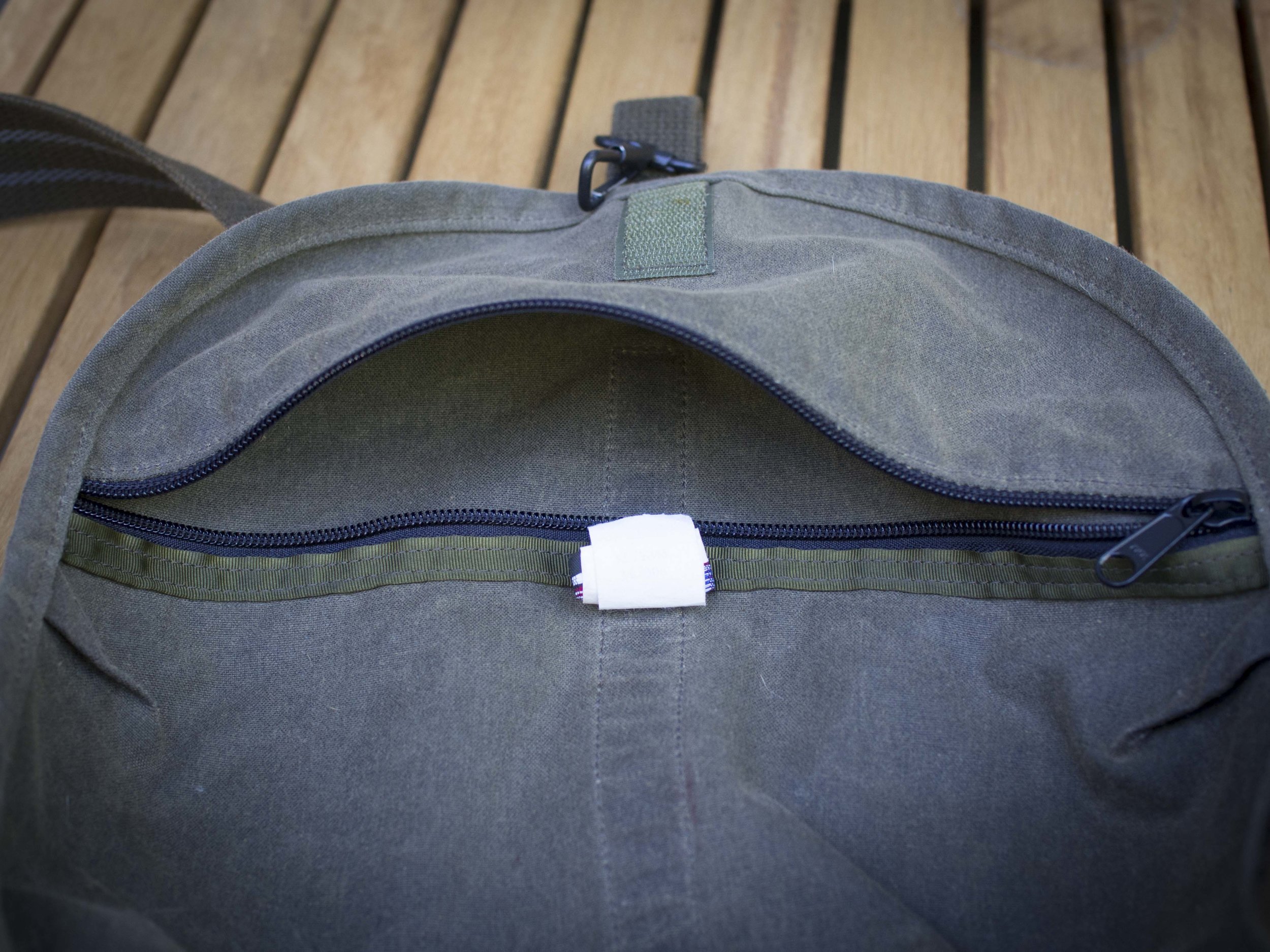
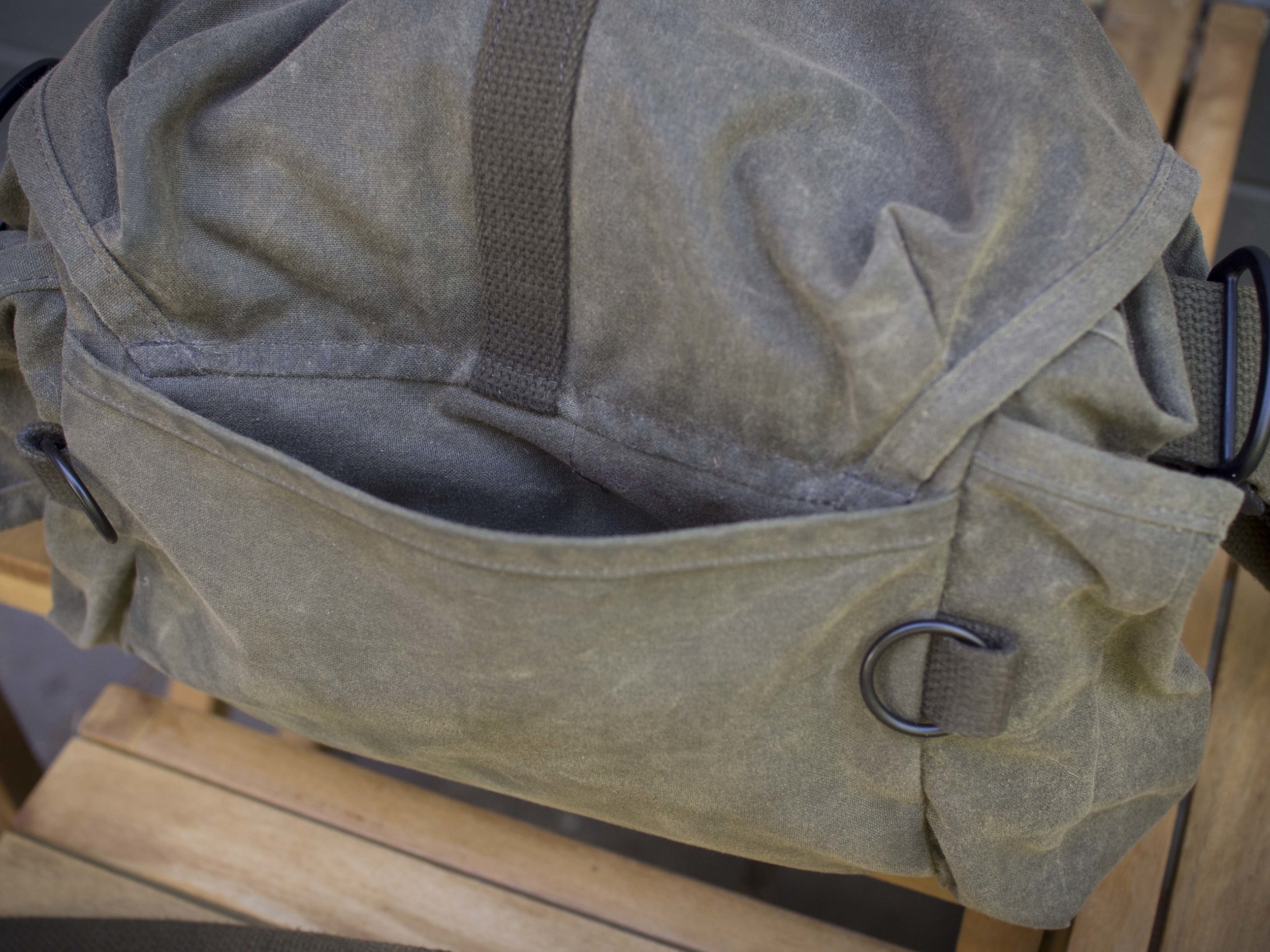
As you can see from above, with nothing removed, it will squash into a suit case easily, but probably put it into a plastic bag as the fabric can leave waxy stains on some clothing and it smells a little "musty", especially when recently re-waxed. The lid also has a pocket like the F2, very secure for small important items and a back pocket big enough for an ipad (again no rain flap or drainage holes, grrrr). Note the two lugs for an optional carry handle or waist belt (the F2 has these as well).
The F3x only has one front clip*, making it easier to access quickly.
What does it hold?
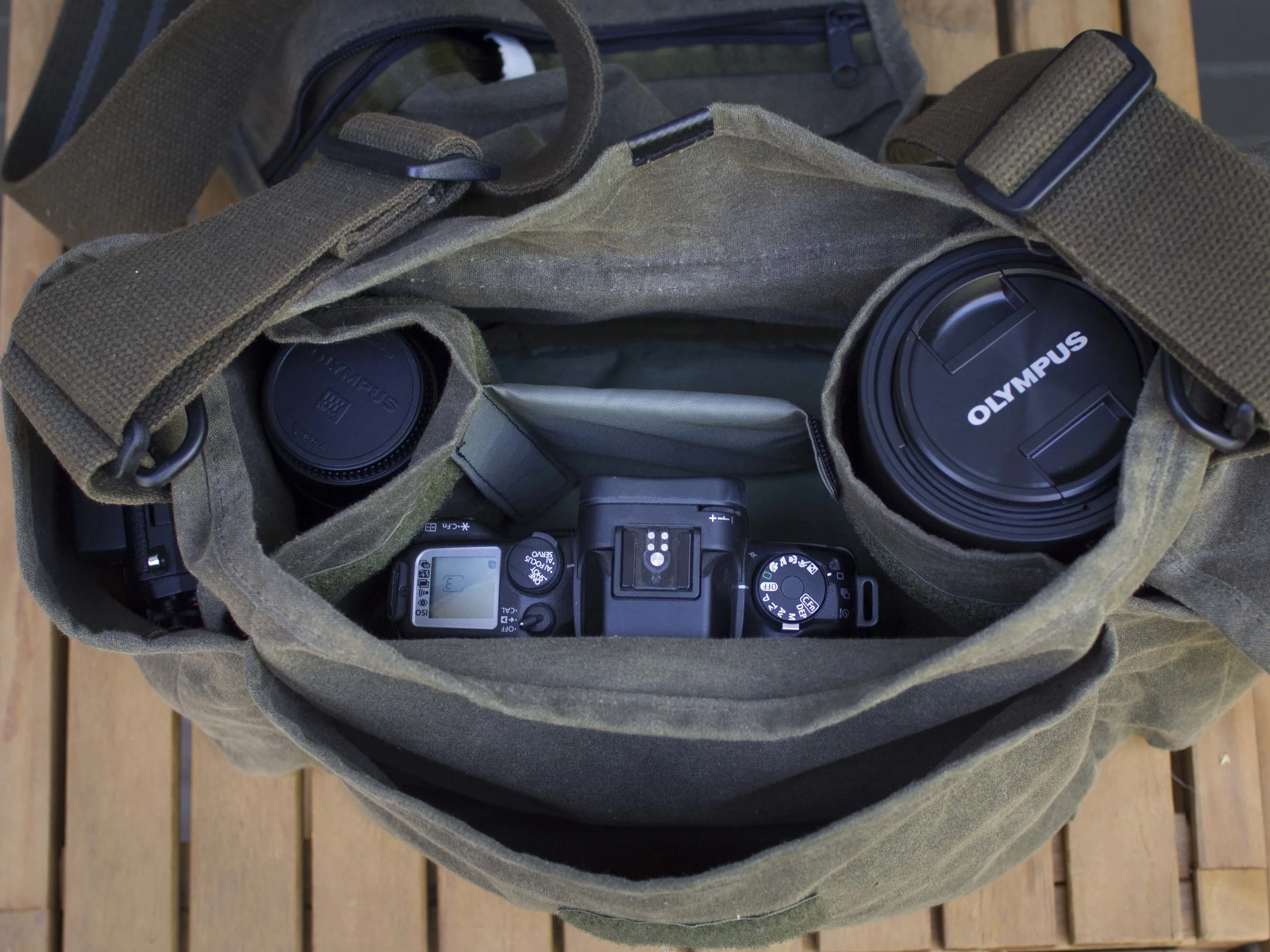
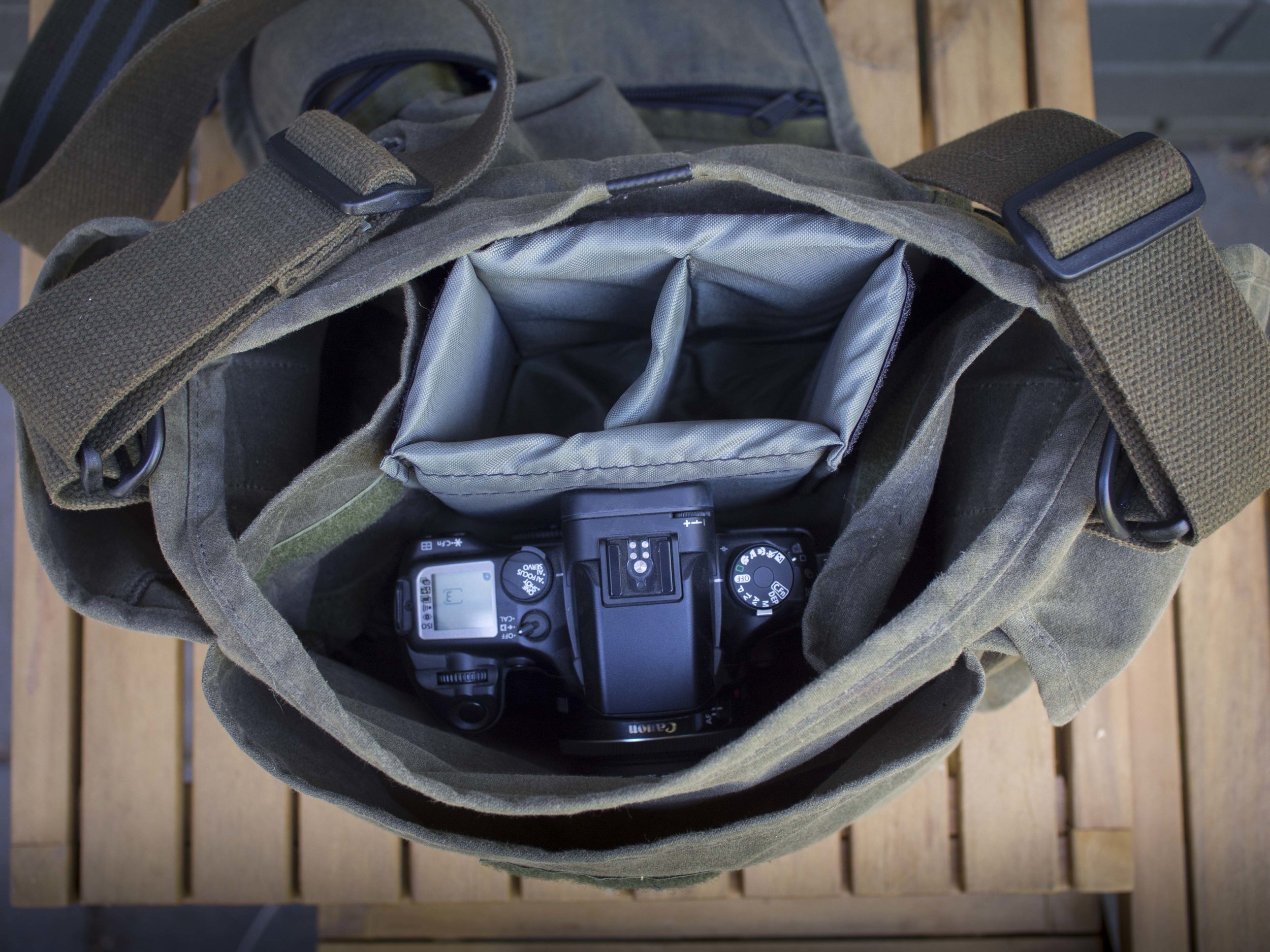
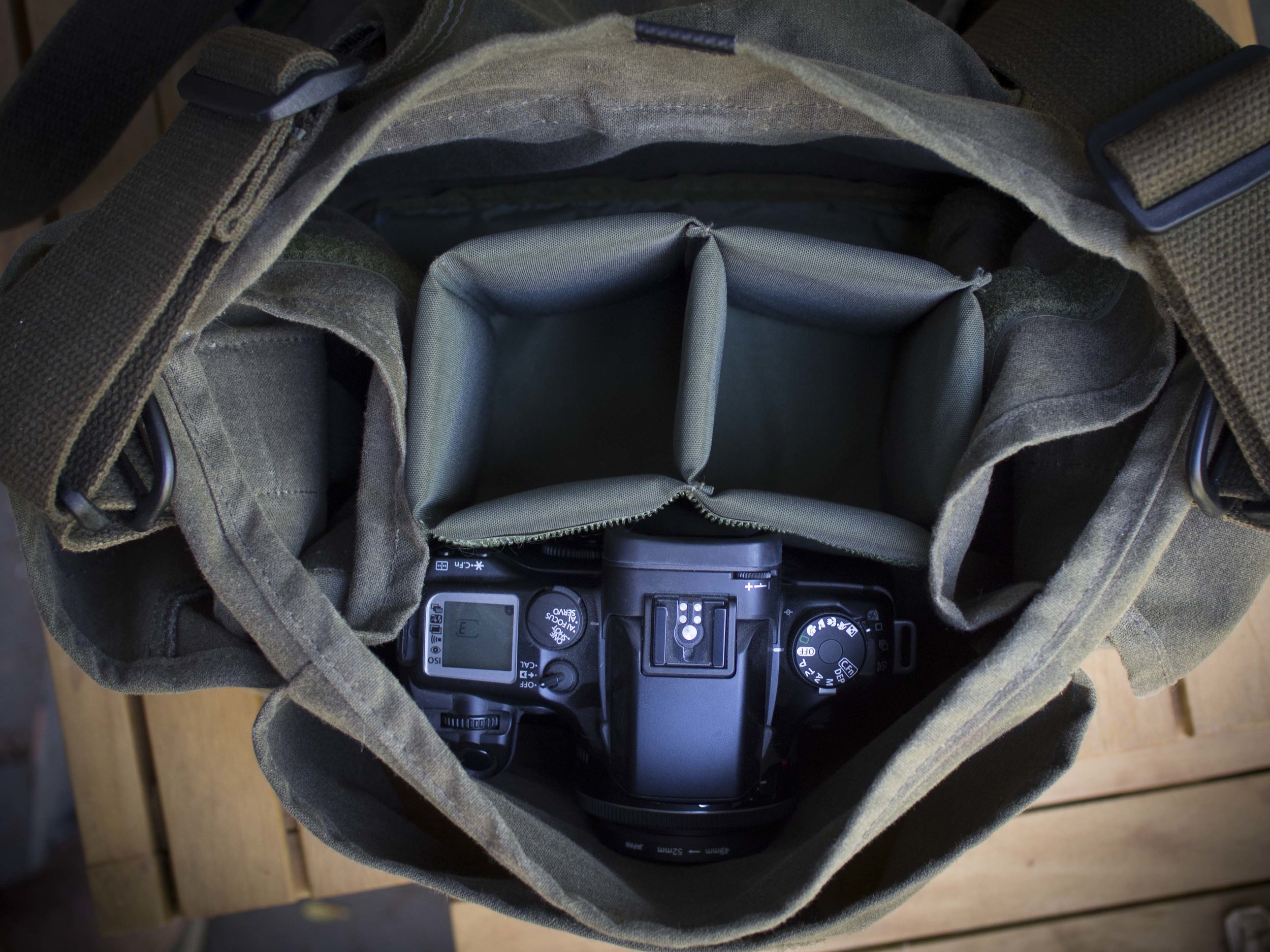
Again the Canon Eos 30 with battery pack is used to show height as the Olympus cameras are swallowed.
The first frame is the standard configuration. The two inside pockets are canvas and extend all the way to the bottom, but are not anchored down. This is important as it gives the user more flexibility and allows some padding to be added to the bag's floor (like a folded scarf- always a handy thing to have) as the F3 only has a thin foam padded bottom. Again this bag swallows small gear which can be an issue with the non anchored compartments. I have had the little 45mm "migrate" from one to another. The lens in the right hand pocket is the 40-150 f2.8, so any older f2.8 or newer F4 full frame 75-300 tele zoom will fit. My first F3 was purchased with a small full frame SLR kit with a pair of F4 “L” series lenses and a fast prime in mind, which is what they were designed for.
If pushed it could hold 3 bodies, 17/25/75/40-150 f2.8/12-40, mini ipad, phone, note book and some flash gear, all with good to OK access and would look surprisingly unstressed. It would also need the postal service shoulder pad!
The second image shows the bag with a Domke optional insert, ideal for small lenses and the third is the same idea with a Billingham small/short insert. If you intend to carry two bodies use a bit of padding in the bag;s back pocket, as a space challenged body with lens on tends to stick into your hip.
Another set up that has worked is to use a square F2 insert and push the sewn-in pockets aside making a standard 4 section compartment.
The side pockets are huge, holding a camera body (the EM5 with grip in the one above is barely touching the sides), large prime, small zoom or flash at a pinch, but again are unpadded. A large pair of long balled-up sports socks floats around in them.
Unlike the F2, the F3 has a single, slightly bigger front pocket that can easily hold an ipad and is weather sealed when the flap is down.
Complaints? The same back pocket one (if I wanted a bucket I would have bought one). The smell and slightly greasy feel that I thought would bother me more, but really does not. The fabric is clearly softer and thinner than the canvas bags, so longevity will not be as good (probably longer than the camera industry as we know it). The shape and size are not ideal for mirrorless cameras, but the beauty of mirrorless is the easy to use size.
Loves. It feels like an unobtrusive old friend.
*
A few thoughts on other Domke bags I have owned.
The F6 is basically an F3 without side pockets. It is a nice little bag, ideal as a mirrorless kit bag as it is more square than tall, so small gear does not disappear inside. the front pocket is zippered also.
The F5b is, I think the ideal day bag for a mirrorless street kit or a minimalist-small SLR kit. Even though it is tiny, it carries easily 2 OMD cameras with small to medium primes attached to each or a smallish (75-300) tele zoom. If I had one it would be coming to Japan next trip (maybe it will come back?).
The F5c. This is a "Tardis" of a bag. The design is odd, but brilliant. They have taken an F5b, added another floor, but given it a front entrance on the ground floor. You can put the same load as the F5b in the top and up to 3 prime lenses or equivalent in the bottom behind the front door, giving you depth without the need to empty out the bag to access the bottom (except the rugged wear F5xz that lacks the front access possibly due to the zip not being as water proof as the fabric?). It comes with two, narrow, three panel, jointed dividers to create steps, straight lines, "L" shapes or "U" shapes inside. I once carried a 5D mk2 with a 35 f2 mounted and 85 f1.8 in the top, a 17-40 L in the lower compartment and a 70-200 F4L lengthways from the top down and it did not feel heavy. My only slight dislike of the F5 bags is the zip top, but the large velcro flap usually makes it unnecessary.
F8. Looks like an F3, but is really small. Watch out for this one as it is really too small to be useful and most online images of it are misleading. An OMD, 45mm and 17mm filled up the inside compartment and the other pockets only held batteries or filters. It is the only Domke I have ever owned that looked over padded for it's size.
Ed. A comment I recieved recently from an F-8 user who said they could fit a 5d4 and two f2.8 zooms into an F8. Well done on that. I could not fit a small M43 kit in mine (it felt like a toy bag, like a kiddies shopping trolley you see at some big chain stores). I do not have one any more , but I did find this excellent article https://www.zigzagging.net/domke-f-8-camera-bag-review/ .
F832. Not sure what I was thinking, but this one is a monster. It looks lovely and actually is, but it is designed for journalists with pro SLR cameras, big lenses with hoods in shooting position and large lap tops etc. Not me at all.
The finishes of the bags can vary a bit. The Ballistic can feel sumptuous in the bigger bags (F2-3), smooth and soft to touch, but much thinner in the smaller bags (F5's). The rugged wear is thin and comfortable against the body as long as the greasiness and smell do not bother you. I don't notice the smell unless I lock the bag in a cupboard for awhile and the greasiness is really only an issue when the bag is freshly done (it comes with a tin of wax).
The canvas is interesting. Many who own older bags say the canvas has lost some of it's weight in newer bags and the F6 I purchased a couple of years ago did feel a lot lighter, but I vaguely remember my first F6 (1990's) being lighter also. The F3/F802 olive bags and lens bag purchased 1-5 years ago are softer feeling than the old F2, but are also 30 years newer.
Are they for everyone? Probably not, but they are popular (often copied), respected and do the job they are designed for. For a very long time as it turns out.
*The clips are wrapped in tape to stop noise. Hate noise and the only two scars my OMD's are nursing came from an un-taped clip striking them pretty hard.
Hope this helps.
Ed. I have since purchased the F-2 in ballistic nylon and used it as my day bag while working at a news paper. It is a nicer, softer take in the original, but not much has changed.

